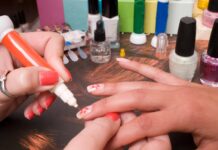Have you ever left a nail salon feeling pampered and refreshed, only to discover a few weeks later that you have developed nail fungus? It can be a frustrating experience, especially when you’re not sure how it happened. In this blog post, we will explore how you can get nail fungus from a nail salon, and provide practical tips for prevention and treatment.
Nail fungus, also known as onychomycosis, is a common condition that affects millions of people every year. It is caused by a fungal infection of the nails, which can lead to discoloration, thickening, and crumbling of the nail. While nail fungus can be caused by a variety of factors, including genetics, poor hygiene, and compromised immune system, one common way to contract the infection is through a nail salon.
When you visit a nail salon, there are several ways in which you can be exposed to nail fungus-causing fungi. One of the main ways is through contaminated tools and equipment. If the salon does not properly sterilize their nail clippers, files, and other instruments between clients, it can lead to the spread of fungal infections. Additionally, if the salon does not maintain proper cleanliness and hygiene standards, the risk of contracting nail fungus increases.
Another way you can get nail fungus from a nail salon is through poor ventilation. Nail fungus thrives in warm and moist environments, so if the salon does not have adequate ventilation or air circulation, it can create an ideal breeding ground for fungi. Sweaty feet, which are common during pedicures, can also increase the risk of fungal infections.
To prevent getting nail fungus from a nail salon, there are several steps you can take. First, make sure to choose a reputable salon that follows strict cleanliness and hygiene protocols. Look for salons that use disposable tools or properly sterilize their instruments between clients. Additionally, make sure the salon has good ventilation and air circulation to reduce the risk of fungal growth.
If you suspect you have already contracted nail fungus from a nail salon, there are several treatment options available. Over-the-counter antifungal creams or nail polishes can help treat mild cases of nail fungus. In more severe cases, oral antifungal medications may be necessary. It’s important to see a dermatologist for an accurate diagnosis and treatment plan.
In conclusion, nail fungus can be an unpleasant and frustrating experience, especially when it is contracted from a nail salon. By being aware of the risks and taking preventive measures, you can reduce your chances of getting nail fungus. Remember to choose a reputable salon, practice good hygiene, and seek treatment if needed. Your nails will thank you for it.












